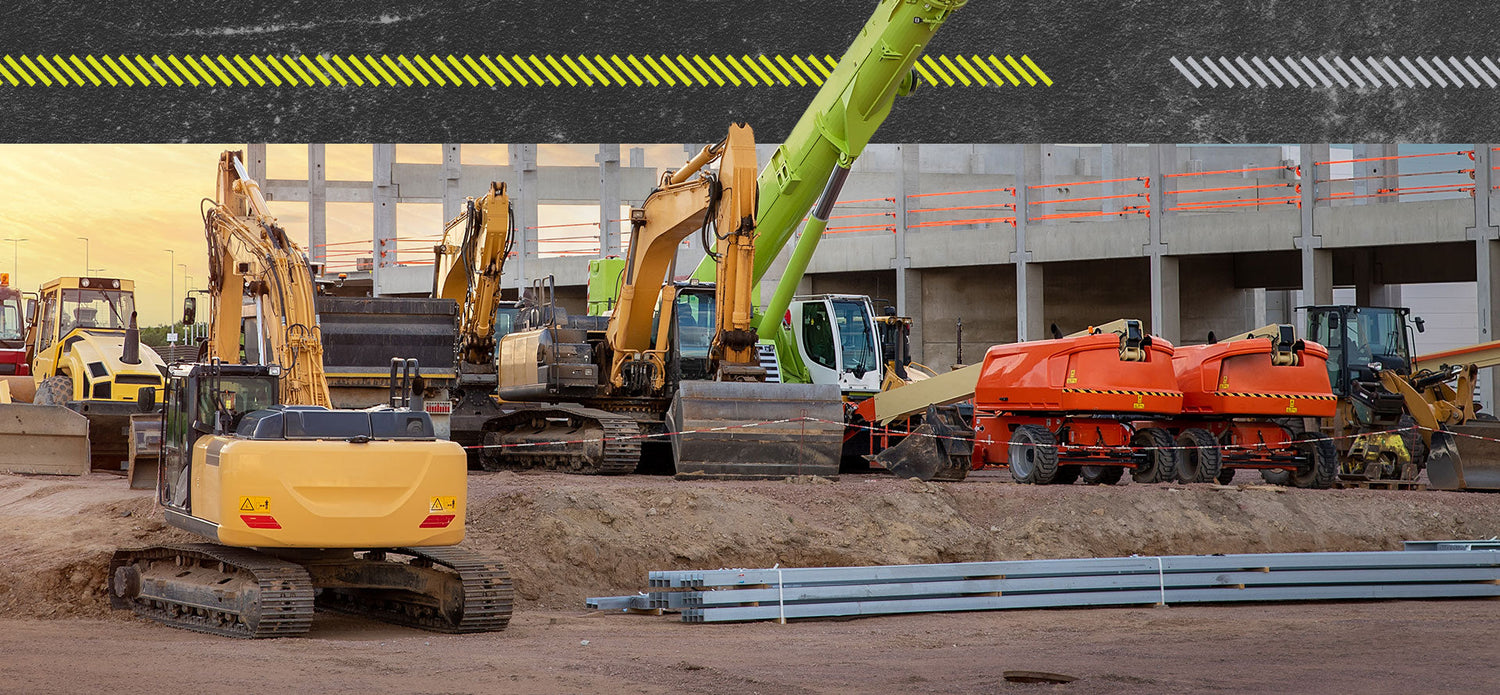Construction sites are among the most hazardous work environments due to heavy machinery, moving vehicles, and constantly evolving conditions. In the high-risk construction industry, following effective safety practices is essential to protect workers from the risk of injury. It is important to be aware of critical construction safety tips, including wearing personal protective equipment (PPE), staying aware of surroundings, and maintaining communication. Wearing high-visibility clothing and hard hats reduces accidents and ensures worker safety. Whether you’re a seasoned professional or new to construction, these tips will help construction managers and workers have a safer work environment.
Top 10 Safety Tips for Construction Workers
Staying safe on a construction site goes beyond just wearing the right protective gear—it involves adhering to a comprehensive set of safety procedures that minimize safety risks and prevent accidents. Here are ten essential safety tips that every construction manager and worker should follow to ensure a safer workplace:
-
Wear Proper Personal Protective Equipment (PPE)
Personal Protective Equipment (PPE) is essential for every construction worker. This includes protection equipment like helmets, gloves, safety glasses, and steel-toed boots to keep workers safe and prevent workplace injuries. High-visibility construction clothing is also crucial for keeping construction workers visible and safe. Ensuring all PPE is in good condition before starting work daily is key to maintaining job site safety.
-
Follow Safety Signage and Signals
Construction safety signs are crucial in alerting workers and visitors to potential hazards and promoting health and safety awareness on construction sites. They must be strategically placed around the site where needed so that workers know about unsafe conditions. All workers should be familiar with signs, including warning signs, safe condition signs, and prohibition signs, as these protection measures help guide workplace safety and prevent accidents.
-
Maintain Clear Communication
On-site communication is essential, especially when working near machinery or moving vehicles. Use hand signals, radios, or direct face-to-face communication to ensure everyone knows their surroundings and any construction site hazards to avoid. Clear, effective communication of safety instructions reduces misunderstandings that could lead to construction site accidents.
-
Site Organization
An organized worksite is a safer one. Ensure that tools and other construction equipment are properly stored when not in use. Clear debris regularly and keep pathways open. A clutter-free site reduces the risk of trips and falls, one of the most common causes of injuries on construction sites.
-
Stay Aware of Your Surroundings
One of the simplest but most important safety measures is to stay alert. Always be aware of what’s happening around you—whether it’s vehicles moving on site, tools used by others, or changing weather conditions. Remaining focused and vigilant helps prevent unexpected accidents.
-
Regular Training
Proper training is not a one-time event; it should be an ongoing practice to ensure all workers are familiar with current safety precautions and procedures. Ongoing safety training sessions help reinforce best practices and introduce new regulations or techniques to improve safety on the job and prevent worker deaths. Regular safety meetings should include the proper use of personal protective equipment (PPE), how to safely operate machinery, and what to do in emergencies. Keeping safety at the forefront of one's mind through training helps prevent accidents before they happen.
-
Inspect Equipment Regularly
Tools, machinery, and vehicles on construction sites undergo constant use and wear, leading to malfunctions or failures if improperly maintained. Regular equipment inspections are crucial to identifying potential problems before they cause accidents. Safety managers should ensure workers are using the correct tools for the job. Workers should inspect their tools and machines at the start of every shift, looking for signs of wear, loose parts, or leaks. Malfunctioning equipment should be taken out of service immediately and repaired or replaced. Staying on top of equipment maintenance is essential to minimizing risks on the job site.
-
Maintain Proper Lighting
Adequate lighting is essential for worker safety, particularly in low-light conditions such as early mornings, late evenings, or overcast weather. Poor lighting can make it difficult to see hazards, increasing the risk of accidents like trips, falls, or struck-by incidents. Ensure the construction site is always well-lit, especially when workers operate heavy equipment or machinery. Portable lighting can also be used where permanent lighting is unavailable, and high-visibility construction shirts can further enhance safety in low-light conditions.
-
Prepare an Emergency Response Plan
An effective construction site safety plan is essential for preventing worker injuries. It should include proper safety procedures for different emergencies, designate roles for quick action, and prominently display emergency contacts. Ongoing training and regular drills help workers stay prepared, and accessible first aid kits ensure rapid injury response. A well-prepared team can minimize panic and enhance safety during a crisis.
-
Report Issues
Reporting safety issues promptly is crucial to preventing accidents. Managers should encourage a culture of safe practices where workers feel responsible for reporting hazards, equipment malfunctions, and near misses. Make reporting easy, act quickly on issues, and provide feedback to reinforce the importance of addressing safety concerns. This proactive approach ensures workplace hazards are resolved before they lead to accidents.
High Visibility Clothing is Essential for Construction Workers
Visibility is a cornerstone of safety on construction sites, especially in high-risk environments with heavy machinery and vehicular traffic. High visibility clothing is not just a precaution—it’s a lifesaver.
Enhancing Worker Visibility in Hazardous Conditions
Construction workers often operate in environments with low light, fog, or heavy dust, which can obscure vision. High visibility clothing, typically designed with fluorescent colors and reflective safety features, makes workers easily noticeable from a distance. This added visibility is particularly critical in areas where machinery or vehicles are in constant motion. High visibility safety gear ensures workers remain seen throughout the day and night, drastically reducing the chances of accidents.
Meeting Safety Standards
OSHA safety standards mandate the use of high visibility clothing in various construction settings. ANSI/ISEA 107-2020 standards categorize high visibility apparel into different classes depending on job-site risk levels. Class 1 clothing suits workers in low-traffic areas, while Class 3 apparel provides the highest visibility for those in high-traffic or low-light conditions.
Reducing Struck-By Accidents
Many construction accidents are caused by “struck-by” incidents, where workers are hit by vehicles or machinery. High-visibility clothing minimizes this risk by making workers highly visible in all directions. The bright fluorescent colors and reflective materials alert large equipment operators, ensuring they can spot workers from any angle, even in less-than-ideal conditions.
The Importance of Hard Hats in Construction Safety
Construction sites are full of potential hazards, and while visibility is important, protecting workers from direct physical impacts is equally critical. Hard hats are a necessary safety tool that protects against head injuries.
Protection Against Falling Objects
Construction workers are often exposed to falling objects like tools, debris, and building materials. A well-fitted construction hard hat absorbs the impact of falling objects, reducing the risk of serious head injuries. Hard hats are a crucial safeguard against potentially fatal accidents, whether working at height or on the ground.
Meeting OSHA and ANSI Standards
Like high-visibility clothing, hard hats are subject to stringent safety regulations. According to the ANSI Z89.1 standard, hard hats are specified by both type and class; For example, Type I, Class G. The following are ANSI types and classes of hard hats and the protection they're designed to provide:
- Type 1: Helmets are intended to reduce impact force from a blow only to the top of the head.
- Type 2: Helmets are intended to reduce the force of impact resulting from a blow to the top or sides of the head.
- Class C: Helmets not intended to protect against contact with electrical hazards (conductive).
- Class G: Helmets intended to reduce the danger of contact with low-voltage conductors (proof-tested at 2,200 volts).
- Class E: Helmets intended to reduce the danger of contact with higher voltage conductors (proof-tested at 20,000 volts).
Protection from Electrical Hazards
Certain hard hats protect against physical impacts and electrical hazards. For example, Class E hard hats are rated for electrical insulation up to 20,000 volts. This makes them indispensable for workers near live electrical lines or in environments where contact with electricity is risky.
By following these construction safety tips—ranging from wearing high-visibility clothing and hard hats to preparing emergency response plans and reporting hazards—workers can significantly reduce the risk of accidents. Prioritizing safety protects individuals and fosters a culture of care and responsibility that benefits the entire team. Remember, a safe site is a productive site, and by staying vigilant, organized, and prepared, construction workers can help ensure everyone goes home safely at the end of each day.







